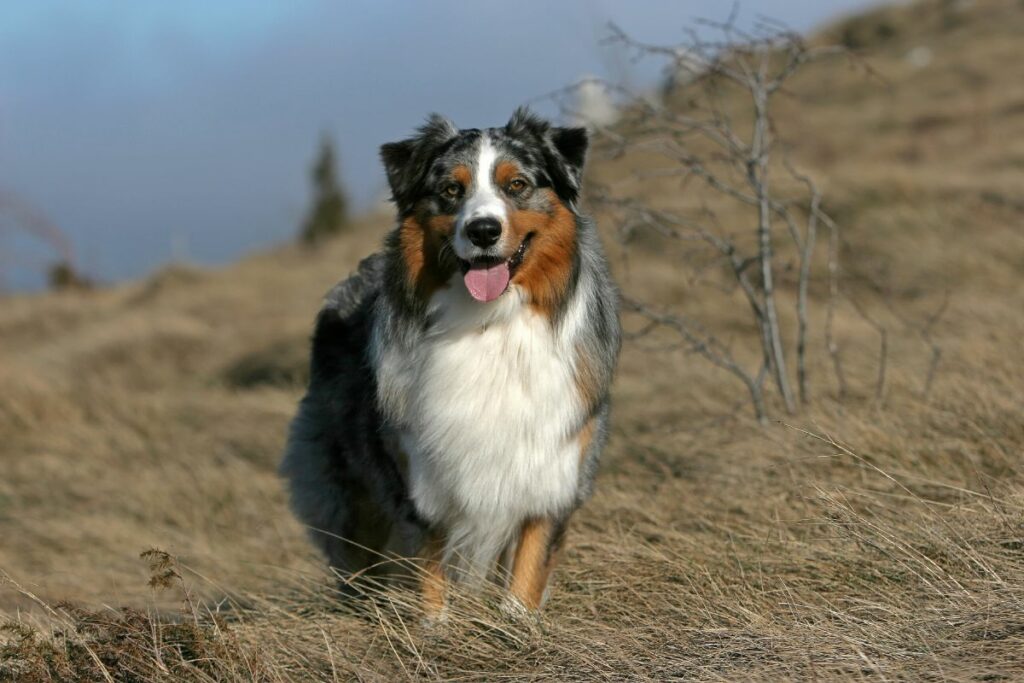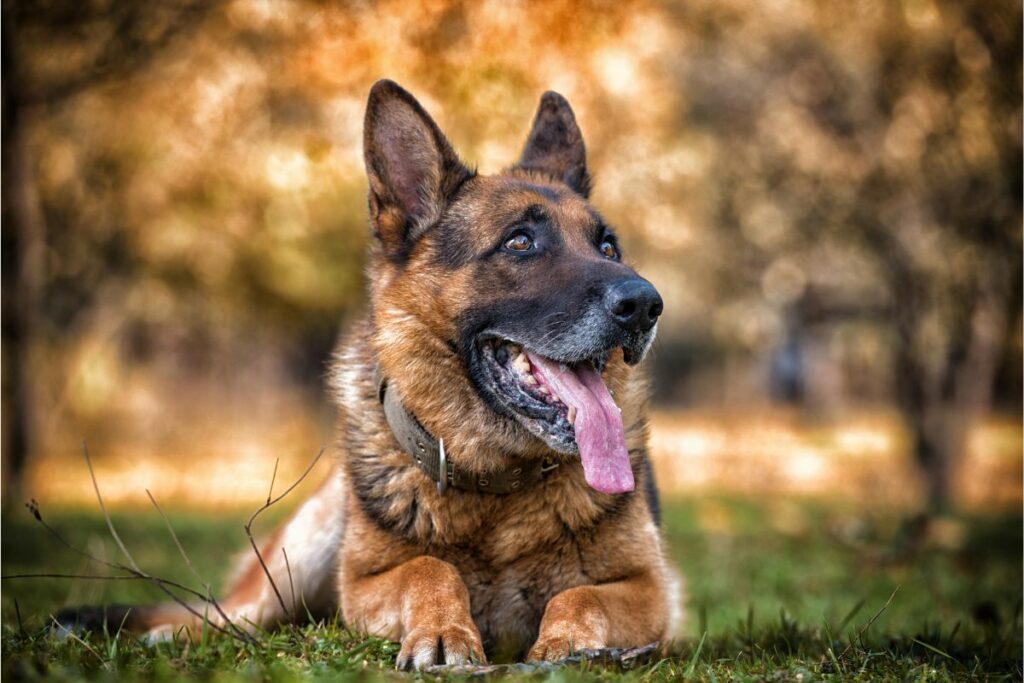Selecting the perfect canine companion is a delightful yet challenging endeavor, and in this exploration, we’ll take a deep dive into the intricate details of two extraordinary breeds—the Australian Shepherd and the German Shepherd.
Celebrated for their intelligence, versatility, and unwavering loyalty, these breeds possess unique qualities that cater to a wide range of diverse preferences.

Join us on a comprehensive journey through their rich histories, temperaments, specific characteristics, potential health concerns, and more in order to help guide you in making a well-informed decision about which of these remarkable dogs is the ideal fit for your lifestyle.
An Introduction To The Breeds
At the heart of the Australian Shepherd vs. German Shepherd debate is the rich history that has shaped both breeds.
Despite its name, the Australian Shepherd’s origins can be traced back to the United States, where it played a pivotal role in herding livestock.
The German Shepherd, on the other hand, with its Teutonic roots, was initially bred for herding and protecting sheep.
As we embark on this comparative journey, understanding the unique histories of both breeds will provide a foundation for appreciating their unique characteristics and approaches to life.
Australian Shepherd: A Versatile Heritage
Bred by Basque shepherds who immigrated to the United States in the 19th century, the Australian Shepherd quickly became an indispensable asset in herding tasks, and their adaptability and intelligence positioned them as versatile working dogs, which doubtless contributed to their popularity as family companions today.
German Shepherd: A Legacy Of Service
The German Shepherd’s story unfolds, rather unsurprisingly, in Germany, where it was meticulously bred for herding duties.
Over time, the breed’s exceptional intelligence and trainability led to it embracing a number of diverse roles, including police and military service, which has helped to reinforce its enduring legacy as a fiercely loyal family dog.
Temperament Traits
Understanding the temperament of each breed is pivotal, especially when considering them as family pets or working companions.
Australian Shepherd: Dynamic and Intelligent Companions
Australian Shepherds are renowned for their energy and agility, and being highly intelligent, they thrive on mental stimulation, and their loyalty and affection make them excellent family pets.
However, their boundless energy requires regular exercise and engagement, and if these basic needs aren’t met, it can lead to them becoming both destructive and disruptive in the family home.
German Shepherd: Courageous And Loyal Guardians
German Shepherds exude courage and confidence. They are loyal, protective, and highly trainable, making them exceptional working dogs, and while they make devoted family members, their protective instincts can make them reserved around strangers.
Physical Characteristics
Their distinctive physical features contribute to the unique charm of each breed.
Australian Shepherd: The Merle Marvel
The Australian Shepherd’s coat is a masterpiece of colors, especially in the mesmerizing merle pattern. Medium-sized and well-balanced, they exude agility and grace, and their expressive eyes, often different colors, add to their allure.
German Shepherd: Strong And Sturdy
German Shepherds are larger and more robust, with a double coat that is usually tan and black or red and black.
Muscular and athletic, they convey strength and endurance, and their always erect ears and alert expression showcase their keen intelligence.

Exercise Requirements
Both breeds need regular exercise, but that doesn’t mean that they both need the same amount of exercise.
Australian Shepherd: Energetic Dynamo
The Australian Shepherd’s herding background has imbued it with an abundance of energy, and daily exercise and mental stimulation are crucial to prevent boredom-related behaviors and the breed adores activities such as agility training, games of fetch, and long walks.
German Shepherd: The Enthusiastic Athlete
German Shepherds are also energetic and require ample exercise to stay physically and mentally fit and excel in activities like obedience training and agility courses.
Engaging them in purposeful tasks and giving them “a job to do” fulfills their need for mental stimulation and increases the bond between the dog and their owners.
Intelligence
Both breeds rank high in intelligence, but their approaches to tasks may differ.
Australian Shepherd: Canine Einstein
Often regarded as one of the smartest dog breeds, Australian Shepherds learn commands quickly and excel in obedience training, and their problem-solving skills and ability to understand complex tasks make them superb working dogs.
German Shepherd: Genius At Work
German Shepherds, no strangers to intelligence tests, exhibit an impressive ability to learn commands and tasks swiftly, and their strong work ethic places them among the most intelligent dog breeds.
Their inherent trainability makes them invaluable in various roles, such as search and rescue.
Trainability
While both breeds are highly trainable, their styles of learning and responsiveness to commands can differ.
Australian Shepherd: Agile Learner
Australian Shepherds thrive on positive reinforcement, and their agility and quick thinking make them adept at learning tricks and commands.
Consistent training with a gentle approach ensures that they will become healthy and happy family dogs.
German Shepherd: Disciplined Dedication
German Shepherds are known for their disciplined approach to training, and they respond well to clear commands and appreciate structure.
Establishing a firm yet loving training routine builds a strong bond and ensures that they can become loving and fiercely loyal family dogs.
Adaptability To Living Conditions
Both breeds need the right environment to thrive in, so you need to think carefully about whether or not your home is the right one for either of the shepherds.
Australian Shepherd: Versatile Companion
Australian Shepherds can adapt well to various living conditions, from apartments to spacious homes, but their need for exercise means that they are better suited to active families who have plenty of outdoor space.
German Shepherd: Space And Security
German Shepherds, being larger, thrive in homes that are, relatively speaking, as big as they are, and their protective instincts make them excellent guard dogs, providing both companionship and security for their families.
Socialization With Other Pets
Harmony among pets is a concern for many prospective dog owners, and it’s important to understand the needs of both breeds and existing pets before you make them part of your family.
Australian Shepherd: Social Butterfly
With proper socialization from an early age, Australian Shepherds can coexist harmoniously with other pets, and their friendly nature means that they can soon become best friends with both cats and other dogs.
German Shepherd: Pack Protector
German Shepherds have a natural protective instinct, which can influence their interactions with other pets, so early socialization is crucial to ensure that they see other animals as part of their pack rather than a threat to the family dynamic.

Health Considerations
Understanding the potential health issues of each breed is vital for proactive care and any insurance that you purchase for their possible veterinary care.
Australian Shepherd: Ocular Challenges
Australian Shepherds are prone to certain genetic health issues, including progressive retinal atrophy (PRA) and cataracts, and regular eye check-ups are essential for the early detection and management of these potential issues.
German Shepherd: Hip And Elbow Dysplasia
German Shepherds are susceptible to hip and elbow dysplasia, which is common among larger breeds, and regular veterinary check-ups, a balanced diet, and moderate exercise can help mitigate these issues and manage them should they occur.
Lifespan Expectancy
Knowing the average lifespan of a breed is essential for the long-term planning of any potential health care they may need.
Australian Shepherd
On average, Australian Shepherds have a lifespan of 12 to 15 years, and regular exercise, a nutritious diet, and routine veterinary care can contribute to and increase their lifespan.
German Shepherd
German Shepherds also have a lifespan of around 10 to 14 years, and like any breed, their lifespan is influenced by factors such as genetics, diet, and overall care.
Grooming Needs
Maintaining a dog’s coat and overall hygiene differs according to breed but is an essential part of ensuring that a dog remains healthy and happy.
Australian Shepherd: Moderate Grooming
The Australian Shepherd’s medium-length coat requires regular brushing to prevent matting and reduce shedding, and they need occasional baths to keep them clean.
German Shepherd: Regular Brushing
German Shepherds shed year-round and said shedding will get heavier with the seasons, so it’s something that any potential owner needs to consider, especially if any member of the family has a pet allergy or related medical condition.
Regular brushing and grooming are needed to manage their dense double coat, and even though they might not be fans of being bathed, they’ll need to spend some time in the tub if you want to keep them clean.
Family Bonding
The emotional connection between a dog and its family is absolutely vital and the reason our four-legged companions earned the nickname, man’s best friend.
Australian Shepherd: Heartfelt Connections
Australian Shepherds are affectionate and form strong bonds with their families, and their loyalty and playful nature make them excellent companions for families with children.
German Shepherd: Devotion Beyond Measure
German Shepherds are known for their unwavering devotion, and they form deep bonds with their owners and are particularly protective, making them excellent choices for families seeking both companionship and security.
The Protective Instincts
Understanding how each breed expresses protective instincts is crucial if a family is looking for security as well as companionship.
Australian Shepherd: Alert Guardian
While Australian Shepherds are alert and may bark to signal potential threats, their protective instincts are subdued and will only really emerge if they think there is a potential threat to their family or their individual wellbeing.
German Shepherd: Natural Protector
German Shepherds are natural protectors, and their loyalty, courage, and discernment make them exceptional guard dogs so it is essential that they receive the right training in order to ensure that they channel their aggression and protective instincts properly and appropriately.
Social Interaction With Strangers
If you’re going to spend a lot of time walking your dog, which both Shepherds need, it’s important to understand how each breed responds to unfamiliar faces and other dogs in a variety of different settings.
Australian Shepherd: Social Welcomer
Australian Shepherds are generally sociable with strangers, especially if introduced properly, and their friendly demeanor makes them approachable to both people and other dogs.
German Shepherd: Reserved Observer
German Shepherds can be reserved around strangers, showcasing their protective instincts, and early socialization helps them differentiate between friend and foe.
In Summary
In the Australian Shepherd vs. German Shepherd debate, the ideal choice ultimately depends on your lifestyle, preferences, and the level of commitment you’re willing to provide.
Both breeds offer unique qualities and challenges, but the joy and companionship they bring far outweigh any other considerations, so whether you’re drawn to the Australian Shepherd’s vibrant energy or the devoted German Shepherd’s loyalty, both breeds will reward your love with a lifetime of companionship and loyalty.
- Breed Comparison: Australian Shepherd Vs. German Shepherd - October 27, 2023
- Your Complete Guide On How To Train A Bernedoodle - October 26, 2023
- The Ultimate Guide On How To Groom A Bernedoodle - October 25, 2023










